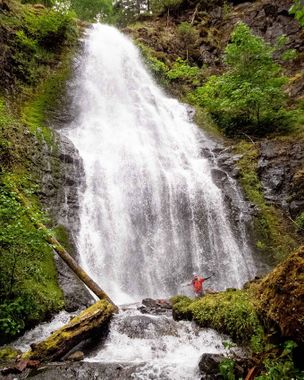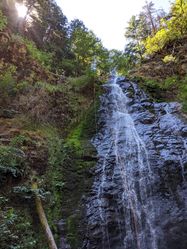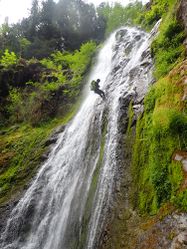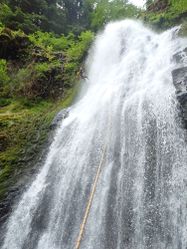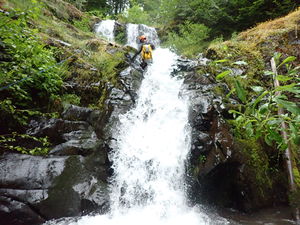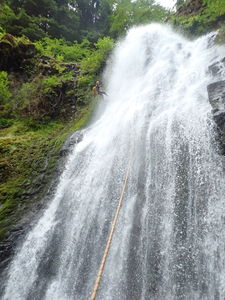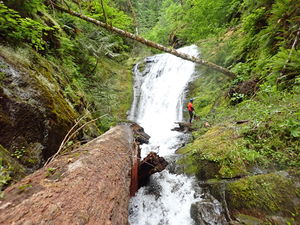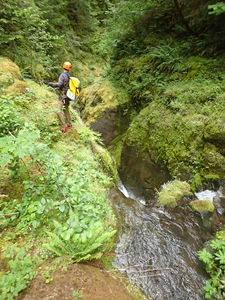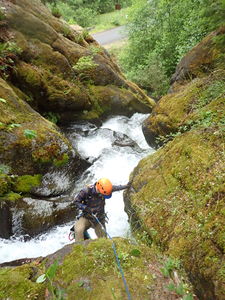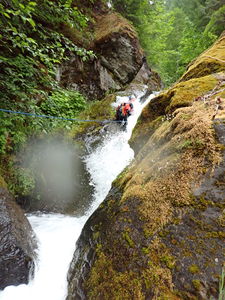Panther Creek (Oregon)
| Rating: | |||||||||||||||||||||||||||||||
|---|---|---|---|---|---|---|---|---|---|---|---|---|---|---|---|---|---|---|---|---|---|---|---|---|---|---|---|---|---|---|---|
| | Raps:7-9, max ↨180ft
Red Tape:No permit required Shuttle:Optional 3.6mi Vehicle:High Clearance | ||||||||||||||||||||||||||||||
| Start: | |||||||||||||||||||||||||||||||
| Parking: | |||||||||||||||||||||||||||||||
| Shuttle: | |||||||||||||||||||||||||||||||
| Condition Reports: | 6 Sep 2024
"I wanted to see this canyon before it starts to get more water in the fall. It was a trickle this time of year.We shuttled cars the gate was open and |
||||||||||||||||||||||||||||||
| Best season: | April-July, BEST in May-June
|
||||||||||||||||||||||||||||||
| Regions: | |||||||||||||||||||||||||||||||
Introduction[edit]
A nice tributary feeding into Quartzville Creek / Green Peter Lake, northeast of Sweet Home, OR. This canyon has some fun rappels and some interesting sections. There is quite a bit of creek walking (0.6mi) before you get to the technical section. Once it starts, it's non-stop action all the way to the bottom. Best in the spring when it has good water. If you're looking for water, don't bother after late June. There are no swimmers on the creek. Deepest pool is about waist-deep.
- It's possible to do a "shortcut" approach directly from the road down to the top of the technical section. This is much shorter at 0.25mi, but it's quite steep with a lot of bushwhacking through old piles of clear cut slash which really slows things down. Hiking in via the creek might actually be faster.
- Watershed: 1mi^2.
Approach[edit]
From Green Peter Dam, head generally northeast on the winding Quartz Creek Rd for ~12mi. Watch for a water gage station and a big sign just before the creek. There is a good pullout for parking at the gage station with room for 5-6 cars. Just past Panther Creek (left) is another pullout (right) which is also a campsite.
- The checkpoint is the view of Panther Creek right from the road. The last rappel is visible.
Shuttle[edit]
Backtrack south on Quartzville Rd for 0.7mi and take the first right on Trout Creek Rd. Gate at the bottom was open in June 2020. Follow it up, staying on the main road at all junctions for ~3mi to where the road crosses Panther Creek. Just before the creek is a large pullout with room for 3-4 vehicles.
- Road up is a bit steep in places and rough in places. A passenger 2WD can make it if driven carefully.
Descent[edit]
From the upper trailhead, walk to where the road crosses the creek and make your way down into the creek on the north side. It's a long-ish walk before the action starts (~0.5mi). Expect the usual Pacific NW creek walking, a little downclimbing and scrambling around obstacles. There are one or two very short slides.
(Once we tried a shortcut route, dropping from the road on the south side directly to the top of waterfall alley. It was steep, overgrown, and pretty much awful. Not recommended. Dropping in from the north side might be better as it's not an old overgrown clear cut?)
- 10ft falls. Downclimb DCR.
- R1: 2-tier from bolts DCL (center). While perhaps 50ft high, it requires ~100ft of rope (SRT) to get down due to the horizontal distance.
A short distance ahead is Panther Creek Falls. This beautiful waterfall is composed of three tiers (R2 & R3). (In high water, you can bypass R2 DCR along a vegetated shelf up to a tree. From the tree to the bottom of R3 requires almost 200ft SRT of rope.)
- R2: 20ft. From a pinch under a giant boulder DCL. First tier of the falls.
- R3: 180ft from two bolts DCL, down the second & third tier. The pull can be difficult; try to move back as far as you can. The first tier is down climbable DCR in low flows and the drop from the last anchor (2 bolts DCL) is only ~130ft. Very hard pull.
- R4: 45ft. From a small tree DCL.
- R5: ~40ft. From a small tree DCL. The creek plunges into a short slot. The exit is blocked by a rootball / fallen tree which could be a strainer in high flow.
Below, the creek enters an interesting "mini-narrows" with lots of short drops. The sides are largely mossy exposed bedrock and wildflowers. It's possible to downclimb most of the drops, but not all. Some of the obstacles can be bypassed along the sides, but please try to avoid trampling vegetation and scraping off the moss. Staying in the water may be a challenge in higher flow and could be dangerous in some areas.
- R6: In the middle of the mini-narrows, the creek suddenly drops 20ft into a short tight slot. Anchored on a thin tree atop a ledge DCL. The second tier of the falls below is easily downclimbed.
Continue through more bedrock areas below.
- R7: 20ft from a tree DCR.
- Cross an area of boulders from a landslide.
- R8: Last rappel down a chute to the road. 25ft from two glue in bolts DCR
Exit[edit]
Exit? What exit? Climb up to the road and walk to your car.
Red tape[edit]
It appears the upper area of Panther Creek may be on private logging land (the approach), but the waterfalls are all on public land below. There is a gate at the bottom of Trout Creek Rd, but it was open in June 2020. If not closed, you can probably drive on up without any issues. It's not signed anywhere that you can't.
Beta sites[edit]
Trip reports and media[edit]
Background[edit]
First descent was made in June 2020 by Kevin Clark, Wade Hewitt, and Wim Aarts.
